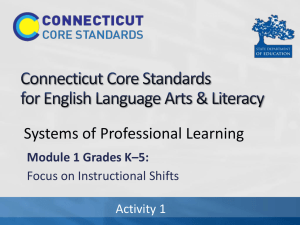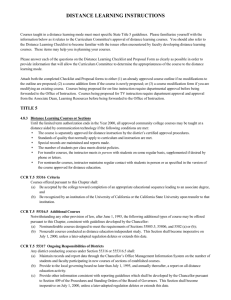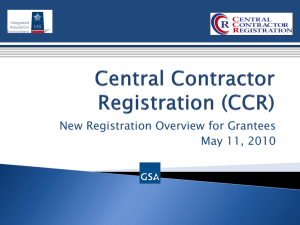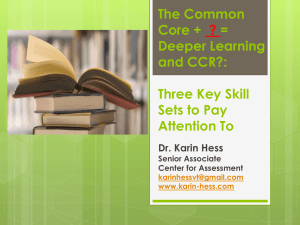Literacy Support Strategies - The Colorado Education Initiative The
advertisement
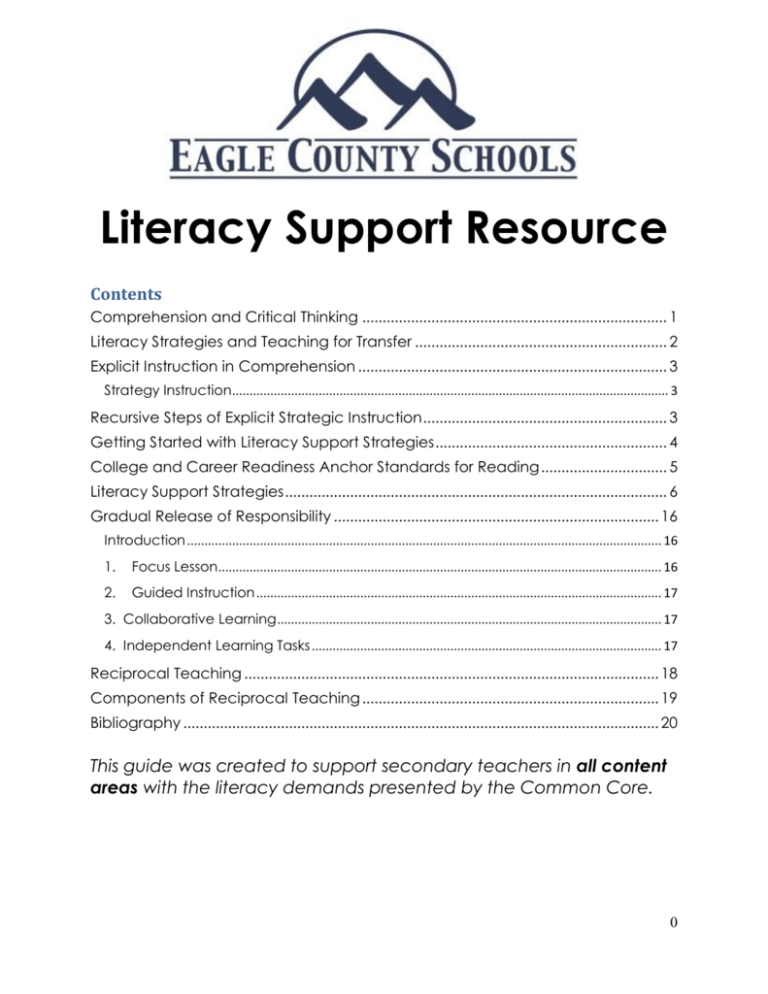
Literacy Support Resource Contents Comprehension and Critical Thinking ........................................................................... 1 Literacy Strategies and Teaching for Transfer .............................................................. 2 Explicit Instruction in Comprehension ............................................................................ 3 Strategy Instruction .............................................................................................................................. 3 Recursive Steps of Explicit Strategic Instruction ............................................................ 3 Getting Started with Literacy Support Strategies ......................................................... 4 College and Career Readiness Anchor Standards for Reading ............................... 5 Literacy Support Strategies .............................................................................................. 6 Gradual Release of Responsibility ................................................................................ 16 Introduction ......................................................................................................................................... 16 1. Focus Lesson ................................................................................................................................ 16 2. Guided Instruction ..................................................................................................................... 17 3. Collaborative Learning ............................................................................................................... 17 4. Independent Learning Tasks ..................................................................................................... 17 Reciprocal Teaching ...................................................................................................... 18 Components of Reciprocal Teaching ......................................................................... 19 Bibliography ..................................................................................................................... 20 This guide was created to support secondary teachers in all content areas with the literacy demands presented by the Common Core. 0 Comprehension and Critical Thinking Comprehension Strategies Inferring Visualizing Questioning the text Determining importance Summarizing Clarifying Making connections (text to world, text to text, text to self) Critical Thinking Strategies Comparing/Contrasting Predicting and Adjusting Sequencing Synthesizing Cause/Effect Relationships Determining author’s purpose Comprehension and critical thinking strategies help answer the deceptively simple question “What do successful readers do when they read?” Many times, unsuccessful readers think that reading just “happens”—they don’t realize that reading is an active process that takes work. Conversely, many successful readers don’t realize just how much they rely on comprehension or critical thinking strategies, since they are practiced at comprehending and making meaning of a text. It’s important to note that any reader can become a struggling reader if the text and situation are difficult or unfamiliar. That is why “the struggle isn’t the issue; the issue is what the reader does when the text gets tough” (Beers 15). 1 Literacy Strategies and Teaching for Transfer Literacy support strategies are temporary scaffolds that support the development of comprehension and critical thinking strategies. When students are engaged in a literacy strategy, what students comprehend and are thinking is made visible to teachers. Therefore, many literacy support strategies can also be used as performances of understanding for teachers to use to identify what students are thinking and how close they are to the learning target. The number of useful literacy support strategies is nearly limitless. There is no list of “perfect” literacy strategies; instead, the usefulness of a strategy is determined by: How the literacy strategy relates to the learning target How the literacy strategy supports the development of comprehension and critical thinking How the literacy strategy is implemented and taught The thinking that the strategy requires students to do Literacy support strategies need to be embedded into contextualized work and used to accomplish a reading purpose or goal. Otherwise, students may view them as “busy work.” Providing explicit instruction in comprehension (see page 3) is imperative in order for students to be able to flexibly and independently use the strategies. Note: When considering literacy support strategies, some distinctions can be made between those that are instructional routines and those that are instructional strategies. A routine might be something that a teacher supports in the classroom but would not be replicated by a student independently outside of the classroom. Examples might be a Socratic Seminar, RAFT writing, or anticipation guides. An instructional strategy, on the other hand, is meant for eventual transfer by the student of both the strategy itself and the skills it helped to create. Examples would be PAS (Preview the text, Access prior knowledge, Set a purpose), use of context clues, and note-taking strategies. Both of these are valuable and serve an important role in the classroom. Understanding this distinction may help schools, departments, and teachers make informed decisions about strategy selection. 2 Explicit Instruction in Comprehension Strategy Instruction “We explicitly teach reading comprehension strategies so that readers can use them to construct meaning. We are likely to teach a strategy by modeling the strategy for the class, guiding students in its practice in small groups and pairs, and providing large blocks of time for students to practice using and applying the strategy. Eventually the goal is for readers to use these strategies automatically and seamlessly” (Goudvis & Harvey, 2007). Recursive Steps of Explicit Strategic Instruction The teacher explains what makes up the strategy. The teacher explains why the strategy is important. The teacher explains when to use the strategy. The teacher models how to perform the strategy in an actual context and the students observe. The teacher sets up guided practice and supports students during class as they try a new strategy. The teacher continues guided practice until students can explain the THE GRADUAL RELEASE OF RESPONSIBILITY MODEL Scaffolded Instruction that Guides Students Toward Strategic Independence For more detailed information on each component of the gradual release of responsibility, please see page 12. strategy and its usefulness and can use it with a variety of texts. Students independently use the strategy in different reading contexts. Adapted from: Harvey, Stephanie and Anne Goudvis. Strategies that Work: Teaching Comprehension to Enhance Understanding. Portland, ME: Stenhouse Publishers, 2000. 3 Fisher, Douglas and Frey, Nancy. Better Learning through Structure Teaching. Alexandria, VA: ASCD, 2008. Getting Started with Literacy Support Strategies The following is a starting point for selecting literacy strategies to support comprehension and critical thinking. Strategies have been loosely divided into four categories: before reading, meaning-making, writing to learn, and vocabulary acquisition. Many factors should be considered when selecting a literacy support strategy for school-wide, department-wide, or individual teacher use. A few, well-selected and well-taught strategies will have the most significant impact on student achievement. This list may be used as one resource in making that decision; however, more information (student need, curriculum goals, assessment evidence, text selection) will need to be gathered before strategies are selected. Knowing how to teach students to use these strategies is imperative if students are to transfer literacy skills to other content areas and situations. The Four Phases of Strategy Instruction help us to gradually release responsibility to the student. Thinking-aloud and reciprocal teaching are a high-effect instructional approaches that also can be used to teach literacy strategies to students. Resources on these instructional approaches are provided at the end of this packet. Each of the following strategies is also indicated in relation to the reading process: Before Reading (also called priming or pre-reading): activating, assessing, and enhancing students’ background knowledge. During Reading (also called processing): helping students comprehend text. After Reading (also called retaining): helping students retain and master what they have learned through reading. In addition, each strategy is aligned with the type of thinking the strategy requires students to use as well as the Common Core Anchor Standard it supports. 4 College and Career Readiness Anchor Standards for Reading Key Ideas and Details R.CCR.1: Read closely to determine what the text says explicitly and to make logical inferences from it; cite specific textual evidence when writing or speaking to support conclusions drawn from the text. R.CCR.2: Determine central ideas or themes of a text and analyze their development; summarize the key supporting details and ideas. R.CCR.3: Analyze how and why individuals, events, or ideas develop and interact over the course of a text. Craft and Structure R.CCR.4: Interpret words and phrases as they are used in a text, including determining technical, connotative, and figurative meanings, and analyze how specific word choices shape meaning or tone. R.CCR.5: Analyze the structure of texts, including how specific sentences, paragraphs, and larger portions of the text (e.g., a section, chapter, scene, or stanza) relate to each other and the whole. R.CCR.6: Assess how point of view or purpose shapes the content and style of a text. Integration of Knowledge and Ideas R.CCR.7: Integrate and evaluate content presented in diverse media and formats, including visually and quantitatively, as well as in words. R.CCR.8: Delineate and evaluate the argument and specific claims in a text, including the validity of the reasoning as well as the relevance and sufficiency of the evidence. R.CCR.9: Analyze how two or more texts address similar themes or topics in order to build knowledge or to compare the approaches the authors take. Range of Reading and Level of Text Complexity R.CCR.10: Read and comprehend complex literary and informational texts independently and proficiently. Refer to the Common Core State Standards for Literacy in History/Social Studies, Science, and Technical Subjects for more detail about each Anchor Standard and the correlating grade-specific standard. 5 Literacy Support Strategies Strategies to Prepare Students for Learning Standard Supported When to Use R.CCR.1 Before During After Literacy Support Strategy Anticipation Guides Type of Thinking Required by Student Description of Strategy Making connections Kylene Beers writes that “an Anticipation Guide is a set of generalizations related to the theme of a selection. Students decide whether they agree or disagree with each statement….[this] gives them a chance to become an active participant with the text before they begin reading” (74-75). Though initially used before reading, they should be used throughout the entire reading process so students can self-monitor their thinking. Anticipation Guides can also be used in support of the “Access” segment of PAS (see below). Wondering and asking questions What I Know What I Want to Learn What I Learned R.CCR.1 R.CCR.2 Before During After KWL Making connections Wondering and asking questions After identifying the topic of discussion/investigation, teachers can help structure student learning by using a KWL. By asking students to consider what they want to learn about a subject, teachers can help them set their own purposes for reading. KWL’s can also be used in support of the “Access” and “Set” segment of PAS (see below). Additional Resources Barton, Science (72-75) Barton, Math (9597) Beers (74-80) Daniels (108-109) Fisher (7-9) Barton, Science (91-94) Barton, Math (109111) Beers (80-87) Daniels (106-107) Fisher (47-49) PAS R.CCR.1 R.CCR.2 R.CCR.4 R.CCR.10 Before During After PAS (Before Reading) Observing closely and describing what’s there Making connections Capturing the heart and forming conclusions Preview the text Examine text features (headings/subheadings, bulleted lists, pictures, captions, charts, graphs, and illustrations) Analyze text structures and features Preview critical vocabulary Access and build prior knowledge Identify the topic Think about what you know about the topic Write or discuss what you know about the topic Think about how you can relate new knowledge to old Set a purpose for reading Understand the assignment Barton, Science (14- 27) Fisher (117-119) for a discussion of text features. Robb (116-132) for a discussion of prior knowledge. Dean and Harper, 2006 6 Understand the demands of the text Read for different purposes (e.g. to learn about _____, to be entertained, to identify the reasons for ______) Understand readers’ purposes/author’s purposes. VIP Visualize Try to picture what you are reading about Experiment with mental movies Talk about what you “see” in the text Interact with the Text Ask yourself questions about what you are reading Mark the important ideas in the text Make connections to what you already know Predict Think about what will come next in the text Check to see if your predictions are correct Observing closely and describing what’s there R.CCR.1 R.CCR.2 R.CCR.4 R.CCR.10 Before During After VIP (During Reading Making connections Capturing the heart and forming conclusions Barton, Science (14- 27) Fisher (117-119) for a discussion of text features. Robb (116-132) for a discussion of prior knowledge. Dean and Harper, 2006 POW Observing closely and describing what’s there R.CCR.1 R.CCR.2 R.CCR.4 R.CCR.10 POW (After Reading Making connections Capturing the heart and forming conclusions Practice Re-read difficult parts of the text Practice reading the difficult parts of the text aloud Organize Information Use graphic organizers Take notes Make lists or outlines Talk about what you have read Write Think about your learning Write summaries Write and answer questions Write your personal connections to the text Barton, Science (14- 27) Fisher (117-119) for a discussion of text features. Robb (116-132) for a discussion of prior knowledge. Dean and Harper, 2006 7 Strategies for Making Meaning and Understanding Observing closely and describing what’s there Considering different viewpoints and perspectives R.CCR.1 R.CCR.6 Before During After SOAPSTone Capturing the heart and forming conclusions SOAPSTone is an acronym that stands for Speaker, Occasion, Audience, Purpose, Subject, and Tone. This strategy helps students to engage in the process of close reading and analysis of poetry, speeches, historical documents/accounts, and expository text. Pre-AP: Interdisciplinary Strategies for English and Social Studies Uncovering complexity and going below the surface of things Observing closely and describing what’s there Building explanations and interpretations R.CCR.1 R.CCR.2 R.CCR.8 R.CCR.10 Before During After Column Notes Reasoning with evidence Making connections Capturing the heart and forming conclusions Observing closely and describing what’s there R.CCR.1 R.CCR.3 R.CCR.4 Before During After Close Reading and TextDependent Questions Building explanations and interpretations Reasoning with evidence Making connections Considering different viewpoints and perspectives Column Notes help teach students to pay attention to what they read, understand text structure, and organize their information and thinking. Note-taking is “closely related to summarizing…students must make a determination as to what is most important, and then state that information in a parsimonious form” (Marzano 43). Some ways for organizing two-column notes are listed below: Main Idea/Detail—for use in analyzing any text Opinion/Proof—for use in analyzing an argument Problem/Solution Cause/Effect Idea from Text/Commentary (my thoughts) Close reading is the methodical investigation of a complex text through answering text dependent questions geared to unpack the text’s meaning. Text dependent questions embrace the key principle of close reading embedded in the CCSS Anchor Reading Standards by asking students to provide evidence from complex text and to draw inferences based on what the text explicitly says (Standards 1 and 10). Effective text- dependent questions are planned for ahead of time and encourage students to spend time lingering over a specific portion of text looking for answers. Some text dependent questions are: Daniels (118-119) Fisher (107-109) Marzano (43- 48) for researched evidence on note-taking. Aspen Institute http://www.aspen institute.org/pu blications/impl ementingcommon-corestatestandardsprimer-closereading-text Ask why the author chose a particular word or phrase. 8 Capturing the heart and forming conclusions Wondering and asking questions Uncovering complexity and going below the surface of things Observing closely and describing what’s there R.CCR.1 R.CCR.2 R.CCR.9 R.CCR.10 Before During After It Says, I Say, So Chart Building explanations & interpretations Reasoning with evidence Making connections Building explanations & interpretations Making connections R.CCR.5 R.CCR.4 R.CCR.9 Before During After Concept Maps/ Graphic Organizers Capturing the heart and forming conclusions Wondering and asking questions Uncovering complexity and going below the surface of things R.CCR.1 R.CCR.7 R.CCR.9 Building explanations & interpretations Before During After Thinking Maps Making connections Ask students to analyze the impact of the syntax of a sentence. Ask students to collect evidence like a detective on the case. Test comprehension of key ideas and arguments. Ask students to analyze how portions of the text relate to each other and the whole. Ask students to look for pivot points in a paragraph. Track down patterns in a text. Notice what is missing or understated. Investigate beginnings and endings. “It Says, I Say, So” is a way of scaffolding inferential (or Level 2) questions for students. Inferences are based upon “the ability to connect what is in the text with what is in the mind to create an educated guess” (Beers 62). This strategy creates a visual representation of the inference-making process. Question It Says I Say So Concept maps include all graphic organizers that help students understand concepts and text. They can be used to enhance understanding of text structure, enhance vocabulary acquisition, allow students to transform information, and improve understanding and recall. Common concept maps include a circle map, a radial map, a classification map, a Venn diagram, a sequence map, and a cause-effect map. Understanding the structure of the text (for example, causeeffect, description, problem-solution) is important for teachers and students to understand. Otherwise, they cannot select or create an appropriate graphic organizer. Thinking Maps may initially seem to be the same as graphic organizers; however, they are based on comprehension/critical thinking skills and are related to current brain research. The goal is to create a common visual language for learning within Beers (165-171) Daniels (122) Barton, Science (87-90) Barton, Math (101105) Daniels (120-121, 126-129) Marzano (17-22, 75-83) See www.thinkingmap s.com for more on Thinking Maps. 9 Capturing the heart and forming conclusions Wondering and asking questions Uncovering complexity and going below the surface of things Wondering and asking questions R.CCR.1 R.CCR.2 R.CCR.5 R.CCR.9 R.CCR.10 Before During After Questions Answer Relationship (QAR) One-Sentence Summary Frames Before During After (based on text structure) Uncovering complexity and going below the surface of things Capturing the heart and forming conclusions Uncovering complexity and going below the surface of things and across disciplines. There are eight thinking maps, all of which have highly flexible forms: circle map (defining context) tree map (for classifying/grouping) bubble map (for describing with adjectives) double bubble map (for comparing/contrasting) flow map (for sequence and ordering) multi-flow map (for analyzing cause and effect) brace map (for identifying part and whole) bridge map (for seeing analogies) This strategy teaches students that all questions are not alike, and it teaches students how to locate information to answer the different types of questions. The reader identifies two main sources of questions: “In the Book” and “In my Head.” In the Book Right There: the answer is in the text and is usually easy to find. Think and Search: the answer is in the text, but you must put together pieces of information from different parts to find it. In my Head Author and Me: the answer is not explicitly stated in the text. You need to think about what you already know, what the author tells you in the text, and how it fits together. On my Own: The answer is not in the text. In fact, you can answer the question without reading the text. These sentence frameworks guide students as they create summaries, one of the most effective strategies for student achievement (Marzano 30). Effective use of a sentence frame is dependent upon matching the summary frame to the appropriate text structure. Different text structures and onesentence summary frames are listed below. Description: _____ is a kind of _____ that _____ Problem/Solution : Somebody wanted _____ but _____ so _____ Sequence: _____ begins with _____ continues with _____ and ends with _____ Comparison/Contrast: x and y are similar in that they are both _____ but x _____ while y _____ Cause/Effect: _____ happens because _____ OR _____ causes________ because_____ Beers (145-152) for “Somebody want/But/So” Marzano (29-42) for researched evidence on summarization 10 Writing To Learn Strategies Writing to learn is different from learning to write. In writing to learn, student understanding can be promoted through the use of writing prompts that occur before, during, and after a process or activity. For instance, after ten minutes of a PowerPoint presentation, a teacher might stop and have students write. Such writing can be either cognitive (related to students’ understanding of the content) or meta-cognitive (related to students’ understanding of their thinking/learning process). Observing closely and describing what’s there Building explanations and interpretations Depending on use, supports all Common Core Reading Anchor Standards Before During After In-Process Writing Prompts Quick Writes Making connections Considering different viewpoints and perspectives Wondering and asking questions Uncovering complexity and going below the surface of things These prompts can be either questions or sentence starters. A few possible sentence starters are listed below. I understand _______ but I’m still confused about ____. The most important idea of this lecture is ___________. I’m struggling with __________ because _____________. ______ is more important for me to remember than _____ because _____________. Alternatively, these prompts can be questions: Before Instruction What do you already know? What questions do you have from the homework? During Instruction What questions do you have? Which aspect of this learning do you find _______ (interesting, convincing, useful, etc.) and which do you not? What examples can you think of that confirm or challenge this learning? After Instruction What are the two most important points from today’s lesson? What ideas do I need to learn more about? Why? What questions do you still have? The format of an in-process writing prompt or quick write can vary. They can be included in any of the following: 30 second power write 2 minute summary or response Think-Write-Pair-Share Entrance/Exit Slips 30 second question list Barton, Math (132133) Barton, Science (114-116) for prompts as they relate to the 5 E’s. Fisher (95-96) Fisher (87-88) 11 Vocabulary Development and Acquisition Building explanations and interpretations R.CCR.4 R.CCR.10 Before During After Word Sorts Making connections Uncovering complexity and going below the surface of things Word sorts help students understand the relationships between key concepts, formulas, or terms. Students are typically given a list of words and then will arrange them into categories. Word sorts can take one of two forms: 1. 2. Open: Teachers give students the words. Students determine their own categories and then arrange the words. Closed: Teachers give students both the words and the categories. In addition to sorting words, students can also sort concepts, objects, phrases, and sentences. R.CCR.4 R.CCR.10 Before During After Word Grid/ Semantic Feature Analysis Building explanations and interpretations A word grid “provides students with an organized framework for learning-related terms through analysis of their similarities and differences” (Fisher 131). There are many ways to arrange them, but the basic form is a table with the vocabulary words/concepts on the left and feature/characteristics on the top row. Then, students indicate (with Y/N or X’s) whether or not the feature is applicable to the term. Below is an example taken from 50 Content Area Strategies (132). 4 Sides Making connections Trapezoid Parallelogram Rhombus Rectangle Square Building explanations and interpretations R.CCR.1 R.CCR.4 R.CCR.10 Before During After S.A.G.E. Making connections Capturing the heart and forming conclusions X X X X X 1 pair of parallel sides X 2 pairs of congruent sides 4 right angles X X X X X X SAGE serves as a checklist for readers, prompting them to search the passage for four types of clues and then infer a possible meaning for an unknown word. Readers do not need to find all four types of clues, only the information that is necessary to gain a sense of a word’s meaning. Barton, Science (69-72) Barton, Math (8485) Beers (251-254, 340-342) Fisher (137-139) Herrell (140- 143) Marzano (13-28) for research on identifying similarities and differences Barton, Science (58-60) Barton, Math (7479) Fisher (131-133) Marzano (13-28) for research on identifying similarities and differences Beers (186-187) 12 Uncovering complexity and going below the surface of things Synonym - What word or phrase in the passage might mean the same? Antonym - What word or phrase in the passage might mean the opposite? Gist - Based on the passage, what is the tone or mood of the word or phrase? What might be its general meaning? Explanation - Does the author anywhere in the passage offer an explanation of the word or phrase? In addition to these clues from context, students can use other forms of context to aid them, or turn to the word itself and examine its parts. Students may also consult outside resources to determine a word’s meaning. Observing closely and describing what’s there Building explanations and interpretations Reasoning with evidence R.CCR.4 R.CCR.10 R.CCR.4 R.CCR.10 Before During After Before During After Frayer Model Making connections Strategic Selection of Vocabulary to Teach The text Teaching Reading in Science defines the Frayer Model as “a word categorization activity that helps learners to develop their understanding of concepts” (53). This graphic representation includes a box divided into quadrants, with a word/concept in the center. Typical versions of the model divide the quadrants in one of two ways: 1. 2. definition (in own words), characteristics, examples, non-examples essential characteristics, nonessential characteristics, examples, non-examples Capturing the heart and forming conclusions Definition Uncovering complexity and going below the surface of things Examples Wondering and asking questions Uncovering complexity and going below the surface of things Characteristics Barton, Science (53-57) Barton, Math (6871) Concept Non-Examples Highlighted in the CCSS is students practice with academic language and domain-specific vocabulary. Therefore, it is important that teachers are intentional about the types of words they teach. Selecting Vocabulary for Instruction Tier One Words – the most basic words that rarely require instruction (clock, baby, happy, walk) Tier Two Words – high frequency words for mature language learners; found across domains; useful Beck, McKeown and Kucan Common Core State Standards, Appendix A (3335) 13 addition to students’ repertoires (coincidence, absurd, industrious, fortunate) Tier Three Words – low frequency words limited to specific domains (isotopes, lathe, peninsula) Teach Tier Two words! Attention to 400 of Tier Two words per year (about 10 words per week) makes a significant impact on reading comprehension. Questions to ask to determine if a word is Tier Two: Do students already have ways to express the concepts represented by these words? Which words will be most useful in helping students understand the material? Criteria for Identifying Tier Two Words: Importance and utility: characteristic of mature language users and appear frequently across a variety of domains Instructional potential: words that can be worked within a variety of ways and connected to other words and concepts Conceptual understanding: words that provide precision and specificity in describing the concept. 14 The purpose of this strategy is for students to determine which vocabulary words will give them trouble when they encounter them in the text. Knowing which words will require extra attention, students can focus their attention on the context in which the word occurs. The teacher selects 5 – 10 words that represent important content to be learned. Students prepare a chart with 5 columns as shown below. They then write the vocabulary words in Column 1. Students then use the Knowledge Rubric to rate how well they know the meaning for each word. Building explanations & interpretations R.CCR.4 R.CCR.10 Before During After Student SelfAssessment of Tier 2 Words RUBRIC 1 2 Don’t Know at All Seen or Heard but Don’t Know Meaning 3 4 Think I Know the Meaning Sure That I Know the Meaning Capturing the heart and forming conclusions Wondering and asking questions Uncovering complexity and going below the surface of things For each word in Column 1, they choose a number from the rubric to indicate their knowledge of the word. They then write the rubric number for each word in Column 2. Next, students get with a partner or small group and discuss each word. A student may change his/her rubric number during your discussion time if a partner or group member explains the word meaning. When discussion has ended, students are given the text and are instructed to number the paragraphs in the text. Next, students locate each word in the text and put a box around it; they may also highlight or underline each word. In Column 3, students indicate which paragraphs include the vocabulary word. If the word appears more than once, students write the number of all of the paragraphs that include the word. Students then read the text and think about what information the author includes about each word. In Column 4 students write a sentence that shows an understanding of the meaning of the word. After the lesson, in Column 5 students rate their new knowledge of each word using the rubric. 15 Gradual Release of Responsibility Introduction The gradual release of responsibility model of instruction suggests that the cognitive load should shift slowly and purposefully from teacher-as-model, to joint responsibility, to independent practice and application by the learner. This gradual release may occur over a day, a week, a month, or a year. Through the process of gradually assuming more and more responsibility for their learning, students become competent, independent learners. The gradual release of responsibility model is the intersection of several theories, including the following: o o o o Piaget's (1952) work on cognitive structures and schema Vygotsky's (1962, 1978) work on zones of proximal development Bandura's (1965) work on attention, retention, reproduction, and motivation Wood, Bruner, and Ross's (1976) work on scaffolded instruction Taken together, these theories suggest that learning occurs through interactions with others, and when these interactions are intentional, specific learning occurs. A common framework for implementing the model is I do it; we do it; you do it. This common framework lacks a vital component: learning through collaboration with peers. A more complete implementation model for the gradual release of responsibility moves from modeled to guided instruction, followed by collaborative learning, and finally independent experiences. 1. Focus Lesson The focus lesson is a time when the teacher demonstrates, models, and shares his or her thinking with students. The focus lesson is a powerful 5-15 minute segment of instruction, when the teacher introduces the concept, skill, or strategy students are expected to 16 learn. The key to a quality focus lesson is explaining the cognitive and metacognitive processes needed. A focus lesson is not a time: o to ask questions or interrogate students about their thinking o to ask students about their predictions, questions, or inferences o for students to read-aloud The three most used methods of focus lessons are modeling, metacognitive awareness, and think-alouds. 2. Guided Instruction Guided instruction is done with small, purposeful, needs-based groups, which are composed based on students' performance on formative assessments. The key to guided instruction lies in the planning for groups which consist of students who share a common instructional need that the teacher can address. Guided instruction establishes high expectations and provides the support for students to reach those expectations. The small groups give teachers the opportunity to: o o o o Vary the instructional materials they use. Adjust the level of prompting or questioning they employ. Differentiate the end products based on the understanding that is being developed. Monitor the instructional needs of students. 3. Collaborative Learning Collaborative learning is an established instructional routine during which students consolidate their thinking and understanding. It is not a time to introduce new information to students. The key to effective collaborative learning is the use of structures which guide group interactions (i.e. reciprocal teaching, assigned roles, specific routines, etc.) and the requirement for independent products that are the result of group collaboration. During collaborative learning students: o o o Negotiate with peers, discussing ideas and consolidating information. Engage in inquiry which causes students to use what they’ve learned during focus lessons and guided instruction. Apply information in novel situations or engage in a spiral review of previous knowledge. 4. Independent Learning Tasks Independent learning tasks need to provide students with opportunities to apply what they have learned through focus lessons, guided instruction, and collaborative learning. Independent learning should help students become increasingly self-directed and engaged. The tasks should allow students to use their reading, writing, and research skills to focus their efforts. During independent learning tasks, the teacher meets with individual students and/or small groups for conferencing. 17 Reciprocal Teaching “Reciprocal teaching was initially devised to be an instructional process to teach students cognitive strategies that may lead to improved learning outcomes. The emphasis is on teachers enabling their students to learn and use cognitive strategies such as summarizing, questioning, clarifying, and predicting, and these are “supported through dialogue between teacher and students as they attempt to gain meaning from text” (Rosenshein & Meister, 1994). Each student takes a turn at being the “teacher” and often the teacher and students take turns leading a dialogue concerning sections of a text. Students check their own understanding of the material by generating questions and summarizing. Expert scaffolding is essential for cognitive development as students move from spectator to performer after repeated modelling by adults. The aim, therefore, is to help students actively bring meaning to the written word, and assist them to monitor their own learning and thinking.” Hattie, J. (2009). Visible learning: A synthesis of over 800 meta-analyses relating to achievement. New York: Routledge Reciprocal teaching highlights four comprehension processes: summarizing, questioning, clarifying, and predicting. Because the emphasis is on understanding these processes, students will need many exposures to all processes. It is advisable to initially teach them one at a time, so that students can deepen their understanding of each before moving on. Therefore, the first four steps in this procedure are not intended to be implemented in one lesson, but rather are spread out over a series of lessons. 1. Begin by introducing summarizing. Share several short readings, such as current newspaper articles, and write summary statements as a class. As students become familiar with summarizing, have them work in groups of four to read a piece of text and work on summaries of specific sections of text. 2. Follow this process for each of the remaining comprehension processes that comprise reciprocal teaching: questioning, clarifying, and predicting. It may take a few weeks for students to understand each of these tasks and the types of conversations they should have with their peers using these processes. 3. Once students understand each of the four components of reciprocal teaching, identify a reading passage or passages Identify specific places in the text where students, in groups of four, should stop and have their reciprocal teaching conversation. Ask students to take turns supplying the information to the group. For example, in his group James may summarize at the first discussion point, then question during the second, and then clarify during the third. 4. After providing several modeled examples and a few practice rounds, distribute the student copies of the other reading or readings (the entire class does not have to be reading the same thing). This time, invite students to take the lead in identifying and locating places to stop and have their reciprocal teaching conversation. Ask them to share their thinking about how they arrived at their decisions. 18 Components of Reciprocal Teaching Summarizing Increases comprehension through discussion. Builds language through interaction. Questioning Focuses on main ideas of text. Students learn which questions provide access to information and which do not. Encourages higher-order questioning Clarifying Students monitor their own comprehension. Use peers to understand vocabulary, references to unknown events. Make connections to themselves, other texts, or the world. Predicting Activate background knowledge. Determine purpose for reading. Make educated guess about the text. Serves as a monitor to confirm or disconfirm prediction. 19 Bibliography Barton, Mary Lee and Clare Heidema. Teaching Reading in Mathematics. 2nd ed. Aurora, CO: McRel, 2002. Barton, Mary Lee and Deborah L. Jordan. Teaching Reading in Science. 2nd ed. Aurora, CO: McRel, 2001. Beck, Isabel L., Margaret G. McKeown, and Linda Kucan. Bringing Words to Life: Robust Vocabulary Instruction. New York: Guilford, 2002. Beers, Kylene. When Kids Can’t Read, What Teachers Can Do: A Guide for Teachers 7- 12. Portsmouth, NH: Stenhouse Publishers, 1999. Daniels, Harvey and Steven Zemelman. Subjects Matter: Every Teachers’ Guide to ContentArea Reading. Portsmouth, NH: Heinemann, 2004. Fisher, Douglas, William Brozo, Nancy Frey, and Gay Ivey. 50 Content Area Strategies for Adolescent Literacy. Columbus, OH: Pearson, 2007. Herrell, Adrienne L. and Michael Jordan. 50 Strategies for Teaching English Language Learners. Columbus, OH: Pearson, 2008. Kappes, Lee, and Sheila Brown. "Implementing the Common Core State Standards: A Primer on "Close Reading of Text"" The Aspen Institute. The Aspen Institute, 09 Oct. 2012. Web. 14 Nov. 2013. <http://www.aspeninstitute.org/publications/implementing-common-corestate-standards-primer-close-reading-text>. Marzano, Robert J., Debra Pickering, and Jane E. Pollock. Classroom Instruction that Works. Alexandria, VA: Association for Supervision and Curriculum Development, 2001. National Governors Association Center for Best Practices, Council of Chief State School Officers. Common Core State Standards. Washington D.C: National Governors Association Center for Best Practices, Council of Chief State School Officers., 2010. Robb, Laura. Teaching Reading in Social Studies, Science, and Math. New York: Scholastic Professional Books, 2003. 20
